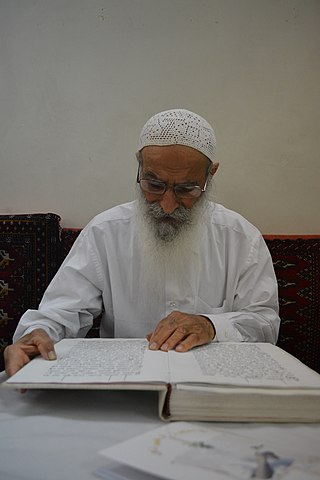In Mandaeism, kushta or kušṭa can have several meanings. Its original literal meaning is "truth" in the Mandaic language, and is thus typically used to refer to the Mandaean religious concept of truth. The same word is also used to refer to a sacred handclasp that is used during Mandaean rituals such as the masbuta, masiqta, and priestly initiation ceremonies.

The Qulasta, also spelled Qolastā in older sources, is a compilation of Mandaean prayers. The Mandaic word qolastā means "collection".
In Mandaeism, Rūha is the queen of the World of Darkness or underworld. She rules the underworld together with her son Ur, the king of the World of Darkness, and her entourage of the seven planets and twelve constellations, who are also her offspring with Ur.
The Diwan Abatur is a Mandaean religious text. It is a large illustrated scroll that is over 20 ft. long.
An uthra or ʿutra is a "divine messenger of the light" in Mandaeism. Charles G. Häberl and James F. McGrath translate it as "excellency". Jorunn Jacobsen Buckley defines them as "Lightworld beings, called 'utras ." Aldihisi (2008) compares them to the yazata of Zoroastrianism. According to E. S. Drower, "an 'uthra is an ethereal being, a spirit of light and Life."

The Left Ginza is one of the two parts of the Ginza Rabba, the longest and the most important holy scripture of Mandaeism. The other part of the Ginza Rabba is the Right Ginza.
Mandaean cosmology is the Gnostic conception of the universe in the religion of Mandaeism.
In Mandaeism, Manda d-Hayyi or Manda ḏ-Hiia is an uthra sent by the Great Life as a messenger to John the Baptist. Manda d-Hayyi is considered to be the most important uthra, since he is the one bringing manda to Earth (Tibil).
In Mandaeism, Hayyi Rabbi, 'The Great Living God', is the supreme God from which all things emanate.

The masiqta is a mass or ritual practiced in the Mandaean religion in order to help guide the soul (nišimta) towards the World of Light in Mandaean cosmology. They are typically performed as funerary rites for Mandaeans who have just died. Although usually translated as "death mass", a few types of masiqta are also performed for living people, such as when priests are ordained. Masiqtas are also used to consecrate houses of worship.

A tarmida is a junior priest in Mandaeism. Ganzibras, or head priests, rank above tarmidas.
Diwan ḏ-Qadaha Rba Šuma ḏ-Mara ḏ-Rabuta u-Dmut Kušṭa, or simply Dmut Kušṭa, is a Mandaean religious text. It is written as an illustrated scroll. No published translation of the text currently exists.

The drabsha or darfash is the symbol of the Mandaean faith. It is typically translated as 'banner'.
In Mandaean cosmology, Piriawis, also known as the Yardna Rabba, is the sacred life-giving river (yardna) of the World of Light. It is the heavenly counterpart of rivers on Earth (Tibil), which are considered by Mandaeans to be manifestations of the heavenly Piriawis.
In Mandaeism, Yawar Ziwa is an uthra from the World of Light. He is the personification of light, as well as the head of reproductive powers.
In Mandaean cosmology, Mshunia Kushta is a part of the World of Light considered to be the dwelling place of heavenly or ideal counterparts (dmuta). It is similar to Plato's concept of the hyperuranion, which can be roughly described as a place in heaven where all ideas of real things are collected together.
The Ṭabahatan is one of the most commonly recited prayers in Mandaeism, in which the reciter asks for the forgiveness of sins. As a commemoration prayer with a long list of names, the prayer starts with the line ṭab ṭaba l-ṭabia. A different version of this prayer is found in DC 42, Šarḥ ḏ-Ṭabahata, which is used during Parwanaya rituals.
In Mandaeism, Nbaṭ is an uthra who is described as the "King of Air" or the "first great Radiance." He is also called Nbaṭ Rba or Nbaṭ Ziwa "the Radiant Nbaṭ", literally "Radiance Burst Forth". In The Thousand and Twelve Questions , he is also known as Kušṭa Yaqra "Solemn Truth".

In Mandaeism, the nishimta or nishma is the human soul. It is can also be considered as equivalent to the "psyche" or "ego". It is distinct from ruha ('spirit'), as well as from mana ('nous'). In Mandaeism, humans are considered to be made up of the physical body (pagra), soul (nišimta), and spirit (ruha).
The following outline is provided as an overview of and topical guide to Mandaeism.







